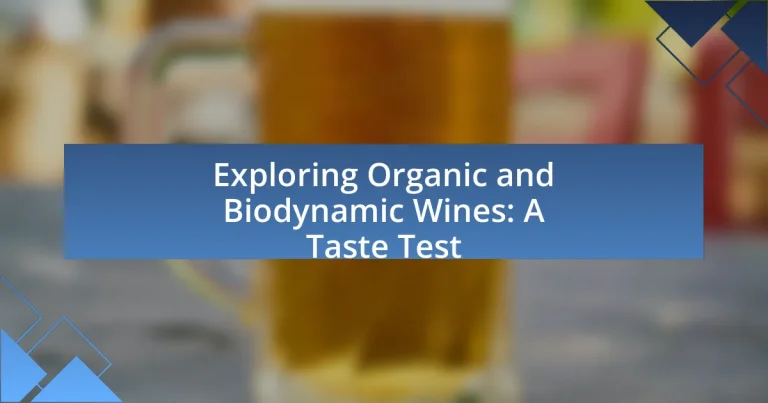Organic and biodynamic wines are produced using sustainable farming practices that prioritize environmental health and ecological balance. Organic wines are made from grapes grown without synthetic pesticides or fertilizers, while biodynamic wines incorporate holistic principles, including lunar cycles and compost preparations. This article explores the differences between organic and conventional wines, the regulations governing their certification, and the health and environmental benefits associated with these wines. Additionally, it examines the unique flavor profiles of organic and biodynamic wines, offering insights into tasting techniques and tips for selecting quality options.

What are Organic and Biodynamic Wines?
Organic wines are produced from grapes grown without the use of synthetic pesticides, herbicides, or fertilizers, adhering to organic farming standards. Biodynamic wines, on the other hand, take organic practices further by incorporating holistic and ecological principles, including the use of compost preparations and following lunar cycles for planting and harvesting. Both types of wines emphasize sustainability and environmental stewardship, with organic wines certified by organizations like the USDA, while biodynamic wines are often certified by Demeter International, which ensures adherence to specific biodynamic practices.
How do Organic Wines differ from Conventional Wines?
Organic wines differ from conventional wines primarily in their production methods, specifically the absence of synthetic pesticides and fertilizers in organic viticulture. Organic wines are made from grapes grown without the use of chemical herbicides, fungicides, or synthetic fertilizers, adhering to strict agricultural standards set by certifying bodies. In contrast, conventional wines often utilize these chemicals to enhance yield and manage pests. According to the USDA, organic farming practices promote biodiversity and soil health, which can lead to more sustainable vineyard ecosystems. Additionally, organic wines may have lower levels of sulfites, as organic regulations limit their use, potentially resulting in different flavor profiles and health implications compared to conventional wines.
What farming practices define Organic Wine production?
Organic wine production is defined by farming practices that prioritize ecological balance and sustainability. These practices include the use of organic grapes, which are grown without synthetic pesticides, herbicides, or fertilizers, ensuring that the vineyard maintains soil health and biodiversity. Additionally, organic wine production often involves crop rotation, cover cropping, and the use of natural compost to enhance soil fertility. According to the USDA, organic certification requires adherence to strict guidelines that promote environmental stewardship and prohibit genetically modified organisms (GMOs). These practices not only contribute to the quality of the wine but also support the health of the surrounding ecosystem.
What regulations govern Organic Wine certification?
Organic Wine certification is governed primarily by regulations set forth by the United States Department of Agriculture (USDA) under the National Organic Program (NOP). These regulations require that organic wine be produced from grapes grown without synthetic pesticides, herbicides, or fertilizers, and that the winemaking process adheres to specific organic standards, including the prohibition of certain additives and processing aids. Additionally, in the European Union, organic wine must comply with EU regulations that similarly restrict the use of synthetic chemicals and outline permissible practices for organic viticulture and vinification. These regulatory frameworks ensure that organic wines meet established criteria for organic production, thereby providing consumers with assurance regarding the integrity of the organic label.
What is Biodynamic Wine and how is it different from Organic Wine?
Biodynamic wine is produced using a holistic approach to farming that incorporates organic practices along with specific spiritual and ecological principles, such as planting and harvesting according to lunar cycles. In contrast, organic wine is made from grapes grown without synthetic pesticides or fertilizers, focusing primarily on the absence of chemical inputs. The key difference lies in biodynamic wine’s emphasis on the vineyard as a self-sustaining ecosystem, which includes the use of compost preparations and the consideration of cosmic influences, while organic wine adheres strictly to organic agricultural standards without these additional philosophies.
What principles underpin Biodynamic farming?
Biodynamic farming is underpinned by principles that emphasize ecological balance, holistic management, and the integration of cosmic rhythms. These principles include the use of organic practices, the incorporation of compost and herbal preparations, and the consideration of lunar and astrological cycles in farming activities. The approach is rooted in the philosophy of Rudolf Steiner, who advocated for a self-sustaining farm ecosystem that enhances soil health and biodiversity. Research has shown that biodynamic methods can improve soil fertility and crop resilience, as evidenced by studies indicating higher microbial activity in biodynamic soils compared to conventional farming practices.
How does the lunar calendar influence Biodynamic practices?
The lunar calendar significantly influences Biodynamic practices by guiding the timing of agricultural activities based on lunar phases. Biodynamic farming adherents believe that the moon’s gravitational pull affects plant growth and soil health, leading them to schedule planting, pruning, and harvesting according to specific lunar cycles. For instance, planting is often recommended during the waxing moon, which is thought to enhance root development, while harvesting is typically aligned with the waning moon to promote the preservation of crops. This approach is rooted in the principles established by Rudolf Steiner, who emphasized the interconnectedness of cosmic rhythms and terrestrial life, thereby providing a framework for Biodynamic agriculture that integrates lunar cycles into its practices.

Why are Organic and Biodynamic Wines gaining popularity?
Organic and biodynamic wines are gaining popularity due to increasing consumer awareness of health and environmental issues. Studies indicate that consumers are more inclined to choose products that are perceived as healthier and more sustainable, with a 2021 survey showing that 60% of wine drinkers prefer organic options. This shift is driven by a desire for natural ingredients, reduced chemical exposure, and support for environmentally friendly farming practices. Additionally, the unique flavors and characteristics attributed to organic and biodynamic methods appeal to wine enthusiasts seeking diverse tasting experiences.
What health benefits are associated with Organic and Biodynamic Wines?
Organic and biodynamic wines are associated with several health benefits, primarily due to their lower levels of sulfites and absence of synthetic pesticides. These wines often contain higher concentrations of antioxidants, such as resveratrol, which can contribute to heart health by improving cardiovascular function and reducing inflammation. Studies indicate that organic wines may also promote better gut health due to the absence of chemical additives that can disrupt the microbiome. Additionally, biodynamic practices enhance soil health and biodiversity, potentially leading to grapes with more complex flavors and nutritional profiles.
How do these wines impact consumer health compared to conventional options?
Organic and biodynamic wines generally have a positive impact on consumer health compared to conventional options due to their lower levels of sulfites and absence of synthetic pesticides. Studies indicate that organic wines contain higher levels of antioxidants, such as resveratrol, which can contribute to cardiovascular health. Additionally, a research article published in the Journal of Agricultural and Food Chemistry found that organic wines have a more favorable phenolic profile, which is linked to various health benefits. This evidence supports the notion that choosing organic and biodynamic wines may lead to better health outcomes for consumers compared to their conventional counterparts.
What are the environmental benefits of choosing Organic and Biodynamic Wines?
Choosing Organic and Biodynamic Wines offers significant environmental benefits, primarily through sustainable farming practices that enhance soil health and biodiversity. Organic viticulture prohibits synthetic pesticides and fertilizers, reducing chemical runoff into ecosystems, while Biodynamic practices promote ecological balance by using compost and natural preparations, fostering a self-sustaining vineyard environment. Research indicates that organic farming can increase soil organic matter by 20-30%, which improves water retention and reduces erosion. Additionally, these practices support local wildlife habitats, as organic vineyards often maintain diverse plant life, which attracts beneficial insects and pollinators.
How do taste profiles of Organic and Biodynamic Wines compare to conventional wines?
Organic and biodynamic wines typically exhibit more complex and nuanced taste profiles compared to conventional wines. This complexity arises from the use of organic farming practices and biodynamic principles, which emphasize soil health, biodiversity, and minimal intervention. Studies have shown that organic and biodynamic wines often have enhanced aromatic qualities and a greater expression of terroir, which refers to the unique characteristics imparted by the vineyard’s environment. For instance, a study published in the Journal of Agricultural and Food Chemistry found that organic wines had higher levels of certain phenolic compounds, contributing to richer flavors and aromas. Additionally, biodynamic wines, which incorporate lunar cycles and holistic farming methods, are often noted for their distinctiveness and depth, further differentiating them from conventional wines that may rely on synthetic additives and fertilizers.
What factors influence the flavor of Organic and Biodynamic Wines?
The flavor of Organic and Biodynamic Wines is influenced primarily by the farming practices, soil health, and the use of natural fermentation processes. Organic farming eliminates synthetic pesticides and fertilizers, promoting biodiversity and healthier soil, which enhances the grapes’ flavor profile. Biodynamic practices go further by incorporating lunar cycles and holistic farming methods, which can lead to more complex flavors due to the increased vitality of the vines. Additionally, the terroir, or the environmental conditions where the grapes are grown, including climate, topography, and soil composition, plays a crucial role in shaping the wine’s taste. Studies have shown that wines produced under these methods often exhibit distinct flavor characteristics compared to conventional wines, highlighting the impact of sustainable agricultural practices on wine quality.
How do winemaking techniques affect the taste of these wines?
Winemaking techniques significantly influence the taste of wines by altering their chemical composition and flavor profiles. For instance, organic winemaking often employs minimal intervention, allowing the natural characteristics of the grapes to shine through, resulting in wines that may exhibit more vibrant fruit flavors and a sense of terroir. In contrast, biodynamic practices, which include specific preparations and lunar cycles, can enhance the complexity and depth of flavors, often leading to wines with unique aromatic profiles and a pronounced minerality. Studies have shown that wines produced using these methods can have lower levels of sulfites and higher levels of antioxidants, contributing to a more nuanced taste experience.

What should consumers consider when tasting Organic and Biodynamic Wines?
Consumers should consider the farming practices and flavor profiles when tasting Organic and Biodynamic Wines. Organic wines are made from grapes grown without synthetic pesticides or fertilizers, while biodynamic wines follow a holistic approach that includes specific agricultural practices and lunar cycles. This distinction can affect the taste, as biodynamic wines often exhibit more complexity and terroir expression due to their unique cultivation methods. Additionally, consumers should be aware of the certification labels, as these indicate adherence to organic or biodynamic standards, ensuring the wine’s quality and authenticity.
How can consumers effectively taste and evaluate these wines?
Consumers can effectively taste and evaluate organic and biodynamic wines by following a systematic approach that includes sensory analysis and contextual understanding. First, consumers should observe the wine’s appearance, noting color and clarity, which can indicate age and quality. Next, they should swirl the wine in the glass to release aromas, then take a moment to inhale deeply, identifying various scents that can reveal the wine’s complexity and varietal characteristics.
After assessing the aroma, consumers should take a small sip, allowing the wine to coat their palate. They should focus on the taste profile, identifying flavors, acidity, tannins, and sweetness. It is essential to consider the wine’s finish, or aftertaste, as it can indicate quality and balance.
To enhance evaluation, consumers can compare different wines side by side, noting differences in flavor and aroma. Additionally, understanding the principles of organic and biodynamic practices can provide context for the wine’s characteristics, as these methods often influence the flavor profile and overall quality.
Research indicates that sensory evaluation is a critical component in wine tasting, as highlighted in studies such as “The Role of Sensory Analysis in Wine Quality Assessment” published in the Journal of Wine Research, which emphasizes the importance of sensory attributes in determining wine quality.
What specific characteristics should tasters look for in Organic and Biodynamic Wines?
Tasters should look for purity of flavor, complexity, and a sense of place in Organic and Biodynamic Wines. Organic wines are characterized by the absence of synthetic pesticides and fertilizers, which often results in cleaner, more vibrant flavors. Biodynamic wines, on the other hand, incorporate holistic farming practices and lunar cycles, leading to wines that exhibit greater complexity and depth. Additionally, tasters should note the wine’s aroma, texture, and finish, as these elements reflect the natural farming methods used. Studies have shown that wines produced under organic and biodynamic practices often have lower levels of sulfites and higher levels of antioxidants, contributing to their unique taste profiles.
How can the tasting experience differ between Organic, Biodynamic, and conventional wines?
The tasting experience of Organic, Biodynamic, and conventional wines can differ significantly due to their production methods. Organic wines are made from grapes grown without synthetic pesticides or fertilizers, often resulting in a more authentic expression of the terroir, which can lead to brighter fruit flavors and a cleaner finish. Biodynamic wines take this a step further by incorporating holistic farming practices and lunar cycles, which can enhance complexity and depth in flavor, often described as having a more vibrant and lively character. Conventional wines, produced with synthetic chemicals and additives, may exhibit a more uniform taste profile, sometimes lacking the distinctiveness found in organic and biodynamic varieties. Studies have shown that consumers often perceive organic and biodynamic wines as having superior quality and flavor complexity compared to conventional wines, supporting the notion that farming practices directly influence the tasting experience.
What are some tips for selecting the best Organic and Biodynamic Wines?
To select the best Organic and Biodynamic Wines, prioritize certifications that ensure compliance with organic and biodynamic farming practices. Look for labels from recognized organizations, such as the USDA Organic seal or Demeter certification for biodynamic wines, which guarantee adherence to specific agricultural standards. Additionally, consider the region and climate, as these factors significantly influence the quality of the grapes; regions known for organic viticulture, like California and France, often produce superior wines. Finally, read reviews and ratings from reputable wine critics or platforms, as they provide insights into the wine’s flavor profile and overall quality, helping you make informed choices.
How can consumers identify quality Organic and Biodynamic Wines in stores?
Consumers can identify quality Organic and Biodynamic Wines in stores by looking for specific certifications and labels. Organic wines must be certified by recognized organizations, such as the USDA in the United States or equivalent bodies in other countries, ensuring that the grapes are grown without synthetic pesticides or fertilizers. Biodynamic wines go a step further, adhering to the principles set by the Demeter Association, which includes practices like using organic compost and following lunar cycles for planting and harvesting. Additionally, consumers should check for tasting notes and reviews from reputable sources, as these can provide insights into the wine’s quality and flavor profile.
What resources are available for learning more about these wines?
Books, websites, and courses are available for learning more about organic and biodynamic wines. Notable books include “The Organic Wine Guide” by John and Julie D’Arcy, which provides insights into organic wine production, and “Biodynamic Wine: A Guide to the Principles and Practices” by Monty Waldin, which explores biodynamic methods. Websites such as Wine Folly and the Biodynamic Association offer articles and resources on these wine types. Additionally, online courses from platforms like MasterClass and Coursera cover wine education, including organic and biodynamic practices, providing structured learning opportunities.


